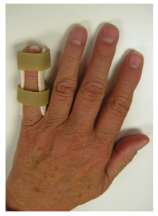|
BOOK NOW |
ASK ABOUT YOUR PAIN |
Home > Blog > Hand Therapy & Customized Splinting > Conditions > Finger, Hand, Wrist, Forearm & Elbow Conditions > Volar Plate Ligament Injury of the Finger Hand Therapy
Volar Plate Ligament Injury of the Finger Hand Therapy
“Working with a knowledgeable hand therapist can make the difference between success and failure in complex hand surgical cases. The therapist extends the continuum of our care, as well as functioning as coach and trainer for our patients.”
Marybeth Ezaki, MD, Past President, American Society for Surgery of the Hand
In Phoenix Rehab, our senior hand therapists are experienced licensed and dedicated therapists (physiotherapists and/or occupational therapists) who specialized ONLY in the rehabilitation, treatment and management of painful fingers, hands, wrists, forearm & elbow conditions, because of interest, passion and expertise.

Volar plate ligament (red) with an avulsion fracture
Our volar plate is a ligament on the palm side of the finger made of tough tissue connecting the finger bones together for stability.
The most common joint of the finger to have a volar plate injury is the one closest to the knuckle called the proximal interphalangeal joint, or PIP.
This volar plate tightens as the PIP joint is straightened and keeps the joint from being bent backward or hyperextended and because of that, our volar plate can be
- sprained
- ruptured or
- avulsed
A sprain occurs when the ligament is stretched or some fibers are torn. A rupture is when the ligament is completely torn. An avulsion is when the ligament is torn away from the bone causing a fracture
What are the symptoms of a volar plate injury?
Initially, the finger may be
- painful
- swollen and
- bruised
around the PIP joint.
Finger motion may be decreased due to pain and swelling. If the PIP joint has been dislocated, it may look out of place.
What are the causes of a volar plate injury?
The most common causes of volar plate injuries are sports or falls when the finger is bent back forcefully. The volar plate can also be injured if the PIP joint is dislocated.

Catching a ball in sports is a common cause of volar plate injury
What is the treatment for a volar plate injury?
Good news is that most volar plate injuries can be treated without surgery.
A physical examination and X-rays may be taken to rule out the possibility of finger fractures.
Treatment may consist of a short period of protection by wearing an orthosis and early exercise. That being said...if the volar plate injury is not stable, surgery might be required.
What can a hand therapist do for me?
It is important to see our senior hand therapists after having a volar plate injury.
We may likely make a custom volar plate splint to protect the finger as it heals. Hand therapy exercises to
- prevent stiffness
- reduce swelling and
- improve strength and function of the hand will be taught in therapy

Example of a finger-protection orthosis for a volar plate injury
Patients may also receive the following hand therapy treatment modalities:
- cold therapy
- heat therapy
- moist heat paraffin wax therapy
- manual therapy
- joint mobilization
- ultrasound therapy
- stretching exercises
- strengthening exercises
- scar management
- etc